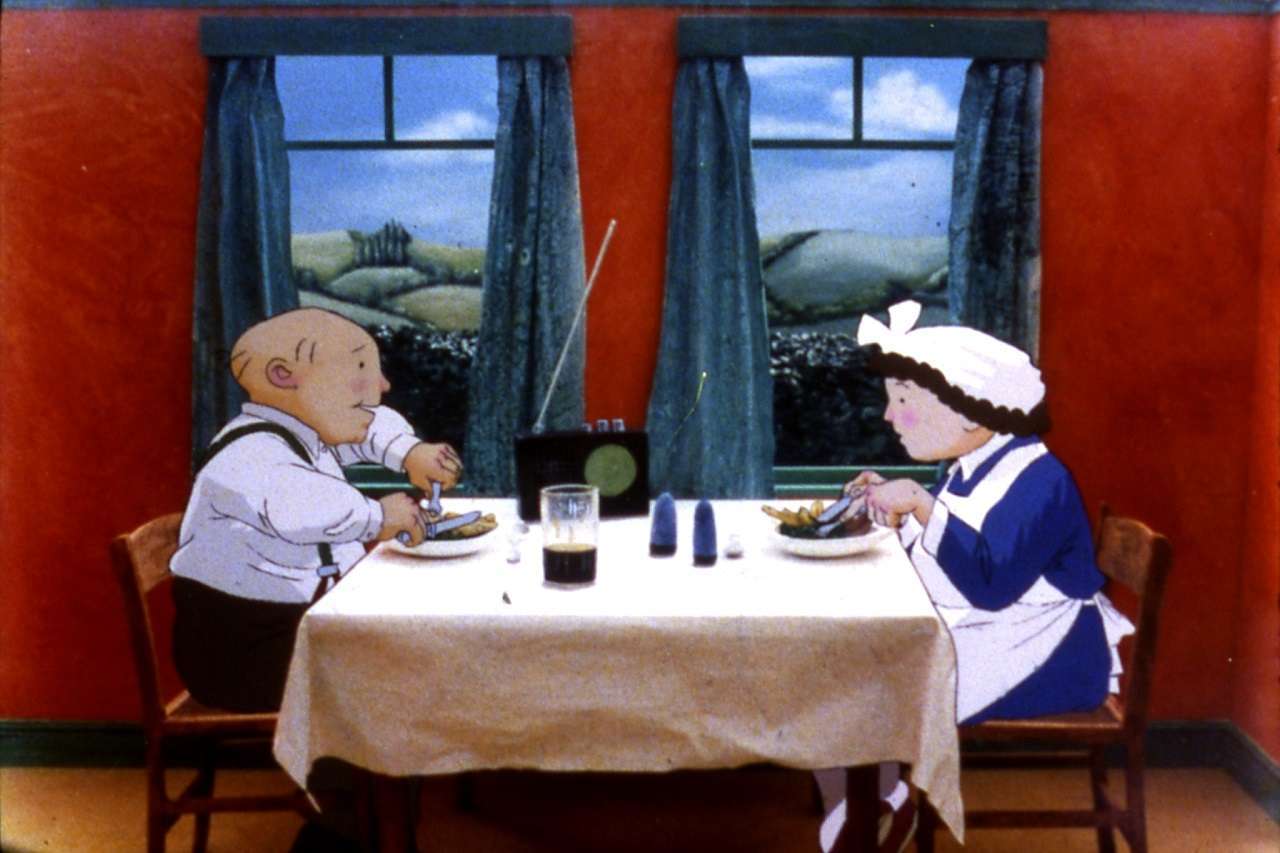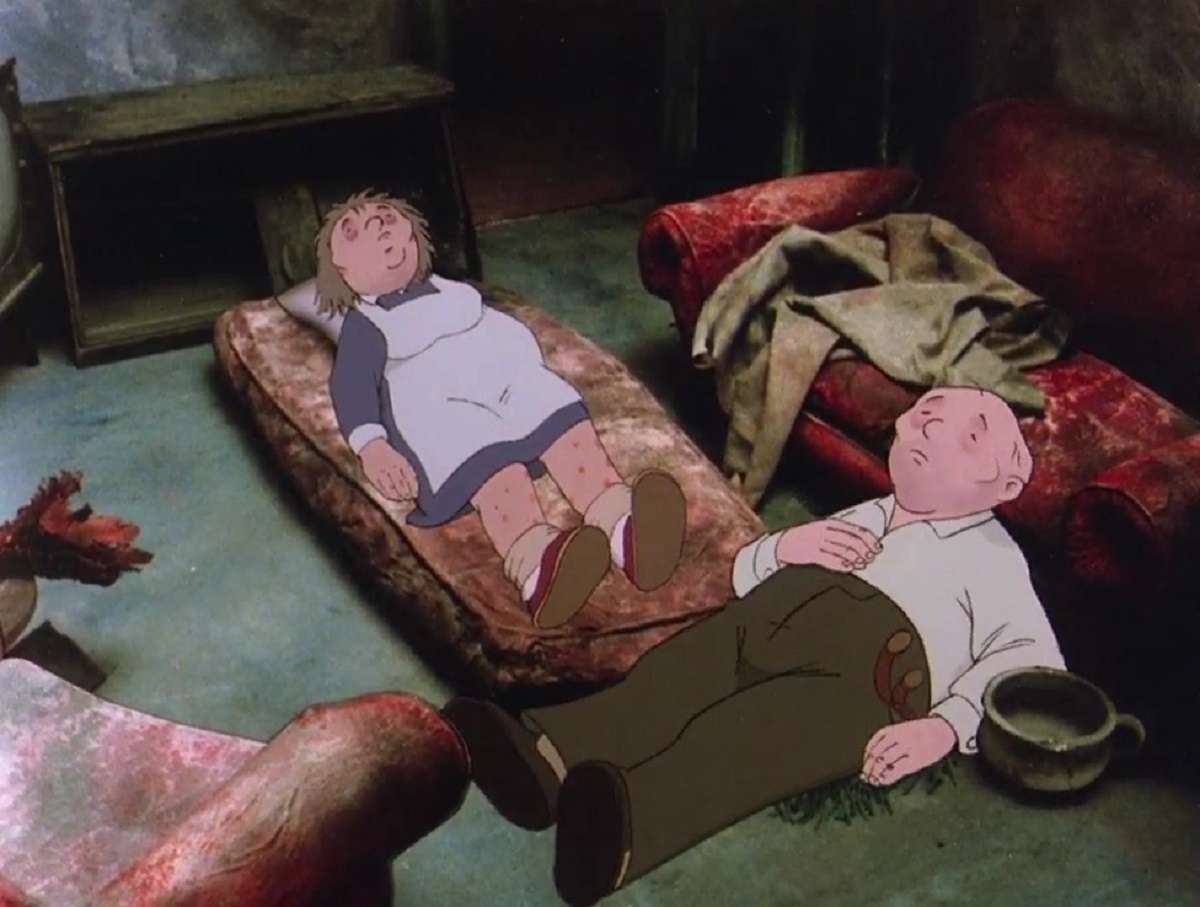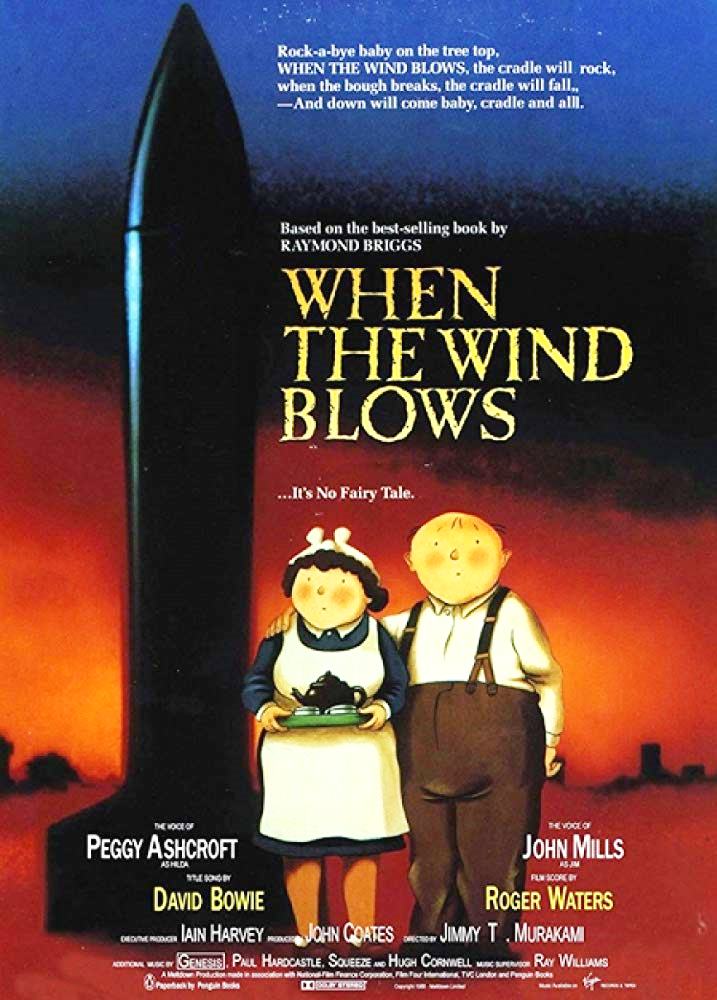UK. 1986.
Crew
Director – Jimmy T. Murakami, Screenplay/Based on the Novel by Raymond Briggs, Producer – John Coates, Music – Roger Waters, Special Effects – Stephen Weston, Art Direction – Errol Bryant & Richard Fawdry, Animation Design – Fawdry. Production Company – Meltdown/Film Four International/TVC London/Penguin Books.
Voices
John Mills (Jim Bloggs), Peggy Ashcroft (Hilda Bloggs)
Plot
Middle-aged Jim Bloggs becomes troubled at the mounting possibility of nuclear war. His wife Hilda is too busy with housework to be concerned. Jim returns home with some civil defence pamphlets and attempts to build a fallout shelter in his living room. The nuclear strike comes. Jim and Hilda make it to the shelter in time but when they emerge they to have to cope with a drastically changed world. At first, they discover that this means wondering when milk and newspaper deliveries will resume and finding that there is no power to boil a cup of tea. Soon they come to realize that the devastation is much wider than that.
When the Wind Blows is an animated feature taken from the popular book by children’s illustrator/writer Raymond Briggs. Raymond Briggs has written books such as Fungus the Bogeyman (1977), The Snowman (1978), The Bear (1994) and Ethel and Ernest (1998) and is regarded as one of Britain’s most popular children’s author/illustrators. During the 1980s, there was an increasingly ardent political tone beneath Raymond Briggs’ work – The Tin Pot Foreign General and the Old Iron Woman (1984) contained a savage caricaturing of Margaret Thatcher and condemnation of the Falklands War. Raymond Briggs also wrote Gentleman Jim (1980), where the characters of Jim and Hilda Bloggs first appeared, which was about an ordinary working-class lavatory worker and his frustrating battles with bureaucratic red tape. Briggs’ follow-up to Gentleman Jim was When the Wind Blows (1982), a savage indictment of the shortcomings of civil defence in the face of a nuclear war. The book was adapted to a popular stage show in 1983 as well as a BBC radio series around the same time.
This film was then made of the book. Raymond Briggs himself wrote the screenplay, while the direction was handed over to Japanese-American Jimmy T. Murakami, a former art director at Roger Corman’s New World Pictures, who had made his live-action directorial debut with Battle Beyond the Stars (1980). When the Wind Blows was one of several British productions during the mid-1980s to tackle the issue of nuclear war – others included tv series such as Threads (1984) and Rules of Engagement (1989).

When the Wind Blows has a blackly satirical edge to it. It is as though Raymond Briggs had taken a civil defence regulations handbook and written the darkest possible dramatisation of the actuality that it talks about. There are many similarities between When the Wind Blows and the brilliant British pseudo-documentary The War Game (1965) wherein director Peter Watkins did exactly the same thing as Raymond Briggs does – showing the disparity between what Civil Defence was advising people to do in the eventuality of a nuclear strike and how woefully short such advice would fall in reality.
The characters of Jim and Hilda Bloggs are voiced with a simplicity that begins to irritate after awhile. However, there soon appears to be a point to this as Jimmy T. Murakami sets them up in order to contrast their naiveté with the grim reality of nuclear war. The images of them falling apart, ineptly trying to interpret Civil Defence instructions, wondering when paper deliveries will resume, and of their dissolution as radiation sickness begins to catch up with them, finally repeating a meaningless hodgepodge of prayer clichés as they die, is incredibly vivid.
Jimmy T. Murakami employs a number of unusual animation techniques, including cutaways from hand drawn animation to three-dimensional models of the living room; sequences that dissolve into animation from montages of stock black-and-white footage of troop movements and WWII newsreels; and some early computer animated sequences of bombers and submarines moving into action. The quality of animation has real beauty – the sweep of the bomb blast across the countryside effortlessly brushing trains, cars and everything in its path aside; the slow-motion tumble of dishes through the house to smash against a portrait, which then comes to life in a series of lap dissolves to give a potted history of the couple; bleak pans up and through the village and devastated countryside where the only life remaining is a dying rat.

The score, from former Pink Floyd frontman Roger Waters (himself a bitter opponent of Margaret Thatcher’s Britain and the mid-1980s nuclear escalation), is excellent, particularly David Bowie’s opening track and Waters’ closing credits number, although the instrumentals show Waters seemingly constrained by their briefness and wanting to open up into something more full-blooded.
Other Raymond Briggs works adapted to the screen are The Snowman (1982), Father Christmas (1991) and The Bear (1999), all 30-minute long animated specials for British television. The Snowman in particular has become a perennial favourite. Fungus the Bogeyman (2004) and Fungus the Bogeyman (2015) were tv mini-series adaptations of the Raymond Briggs book.
Trailer here

